The Cambridge History of Japan, Vol. 4: Early Modern Japan
Подождите немного. Документ загружается.

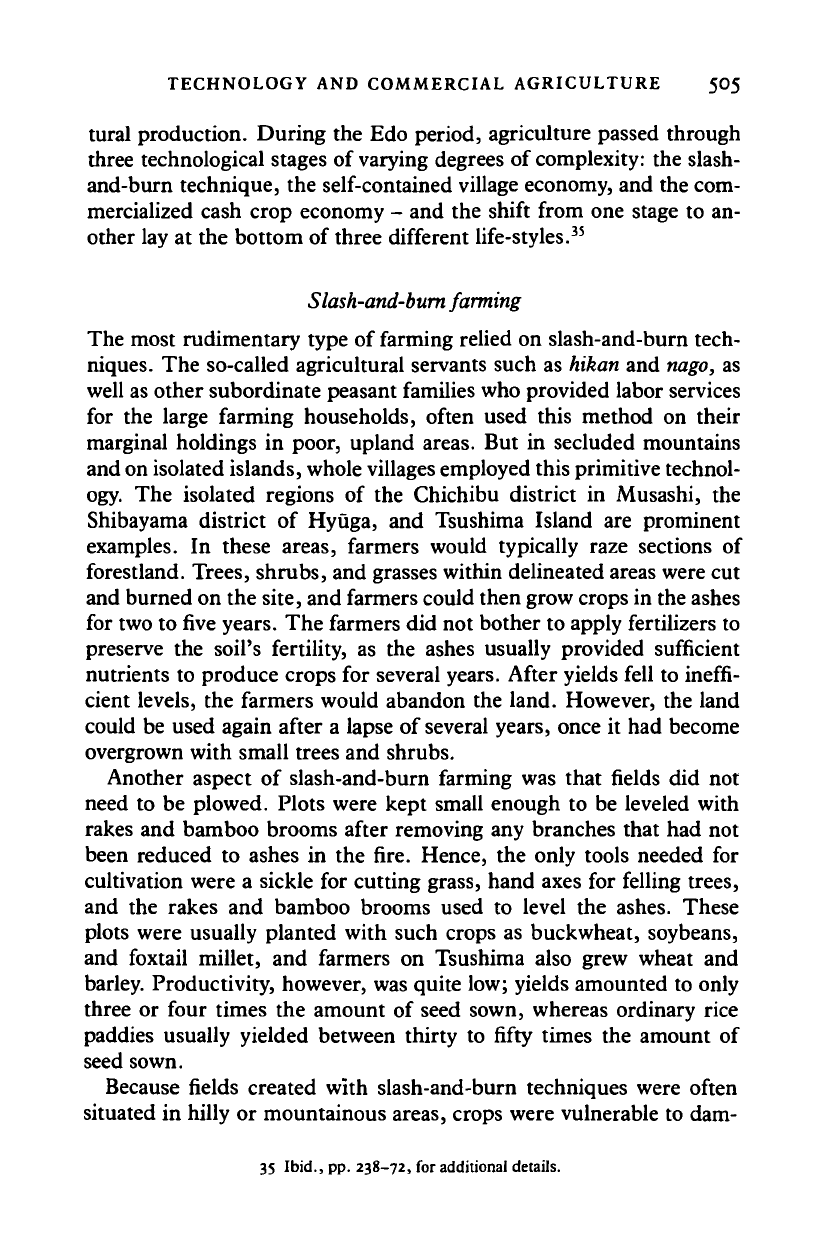
TECHNOLOGY AND COMMERCIAL AGRICULTURE 505
tural production. During the Edo period, agriculture passed through
three technological stages of varying degrees of complexity: the slash-
and-burn technique, the self-contained village economy, and the com-
mercialized cash crop economy - and the shift from one stage to an-
other lay at the bottom of three different life-styles.
35
Slash-and-burn farming
The most rudimentary type of farming relied on slash-and-burn tech-
niques. The so-called agricultural servants such as hikan and
nago,
as
well as other subordinate peasant families who provided labor services
for the large farming households, often used this method on their
marginal holdings in poor, upland areas. But in secluded mountains
and on isolated islands, whole villages employed this primitive technol-
ogy. The isolated regions of the Chichibu district in Musashi, the
Shibayama district of Hyuga, and Tsushima Island are prominent
examples. In these areas, farmers would typically raze sections of
forestland. Trees, shrubs, and grasses within delineated areas were cut
and burned on the site, and farmers could then grow crops in the ashes
for two to five years. The farmers did not bother to apply fertilizers to
preserve the soil's fertility, as the ashes usually provided sufficient
nutrients to produce crops for several years. After yields fell to ineffi-
cient levels, the farmers would abandon the land. However, the land
could be used again after a lapse of several years, once it had become
overgrown with small trees and shrubs.
Another aspect of slash-and-burn farming was that fields did not
need to be plowed. Plots were kept small enough to be leveled with
rakes and bamboo brooms after removing any branches that had not
been reduced to ashes in the fire. Hence, the only tools needed for
cultivation were a sickle for cutting grass, hand axes for felling trees,
and the rakes and bamboo brooms used to level the ashes. These
plots were usually planted with such crops as buckwheat, soybeans,
and foxtail millet, and farmers on Tsushima also grew wheat and
barley. Productivity, however, was quite low; yields amounted to only
three or four times the amount of seed sown, whereas ordinary rice
paddies usually yielded between thirty to fifty times the amount of
seed sown.
Because fields created with slash-and-burn techniques were often
situated in hilly or mountainous areas, crops were vulnerable to dam-
35 Ibid., pp. 238-72, for additional details.
Cambridge Histories Online © Cambridge University Press, 2008
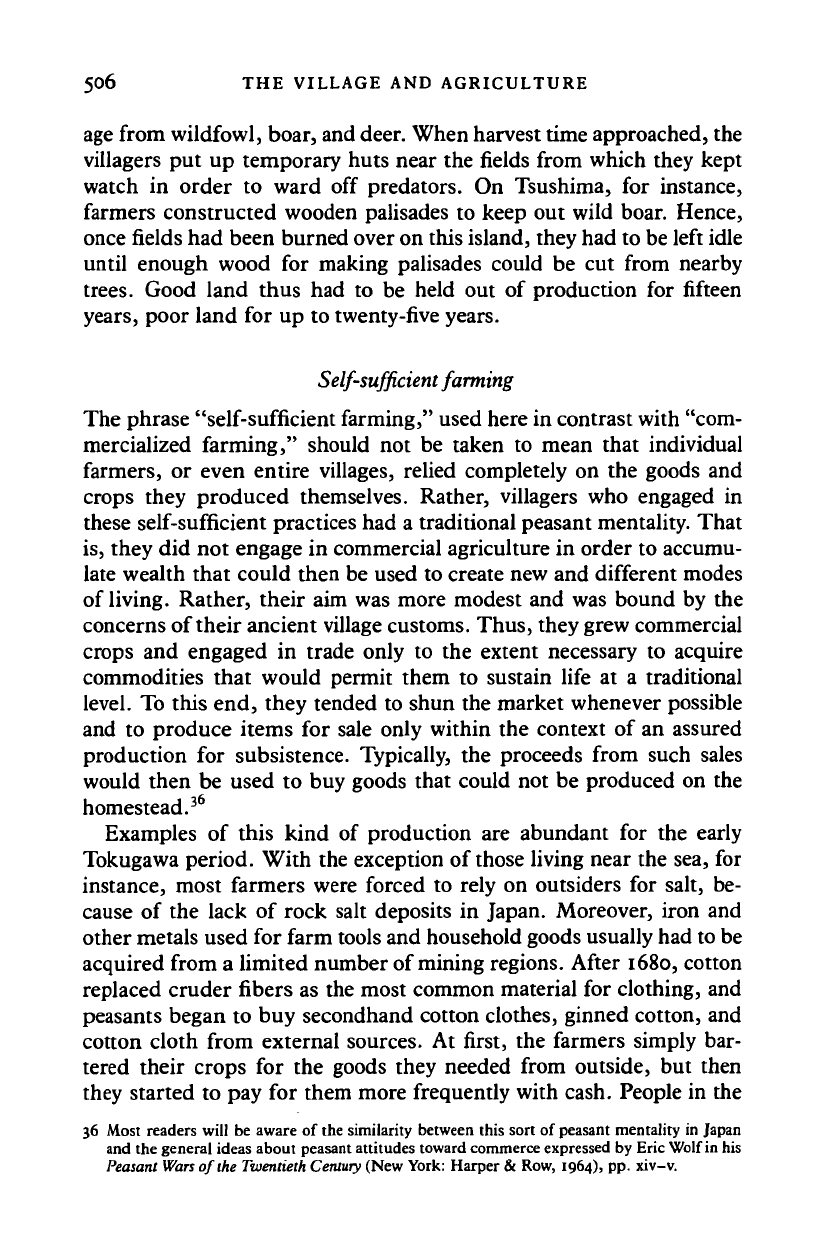
506 THE VILLAGE AND AGRICULTURE
age from wildfowl, boar, and deer. When harvest time approached, the
villagers put up temporary huts near the fields from which they kept
watch in order to ward off predators. On Tsushima, for instance,
farmers constructed wooden palisades to keep out wild boar. Hence,
once fields had been burned over on this island, they had to be left idle
until enough wood for making palisades could be cut from nearby
trees.
Good land thus had to be held out of production for fifteen
years,
poor land for up to twenty-five years.
Self-sufficient farming
The phrase "self-sufficient farming," used here in contrast with "com-
mercialized farming," should not be taken to mean that individual
farmers, or even entire villages, relied completely on the goods and
crops they produced themselves. Rather, villagers who engaged in
these self-sufficient practices had a traditional peasant mentality. That
is,
they did not engage in commercial agriculture in order to accumu-
late wealth that could then be used to create new and different modes
of living. Rather, their aim was more modest and was bound by the
concerns of their ancient village customs. Thus, they grew commercial
crops and engaged in trade only to the extent necessary to acquire
commodities that would permit them to sustain life at a traditional
level. To this end, they tended to shun the market whenever possible
and to produce items for sale only within the context of an assured
production for subsistence. Typically, the proceeds from such sales
would then be used to buy goods that could not be produced on the
homestead.
36
Examples of this kind of production are abundant for the early
Tokugawa period. With the exception of those living near the sea, for
instance, most farmers were forced to rely on outsiders for salt, be-
cause of the lack of rock salt deposits in Japan. Moreover, iron and
other metals used for farm tools and household goods usually had to be
acquired from a limited number of mining regions. After 1680, cotton
replaced cruder fibers as the most common material for clothing, and
peasants began to buy secondhand cotton clothes, ginned cotton, and
cotton cloth from external sources. At first, the farmers simply bar-
tered their crops for the goods they needed from outside, but then
they started to pay for them more frequently with cash. People in the
36 Most readers will be aware of the similarity between this sort of peasant mentality in Japan
and the general ideas about peasant attitudes toward commerce expressed by Eric Wolf
in
his
Peasant
Wars
of the Twentieth
Century
(New York: Harper & Row, 1964), pp. xiv-v.
Cambridge Histories Online © Cambridge University Press, 2008
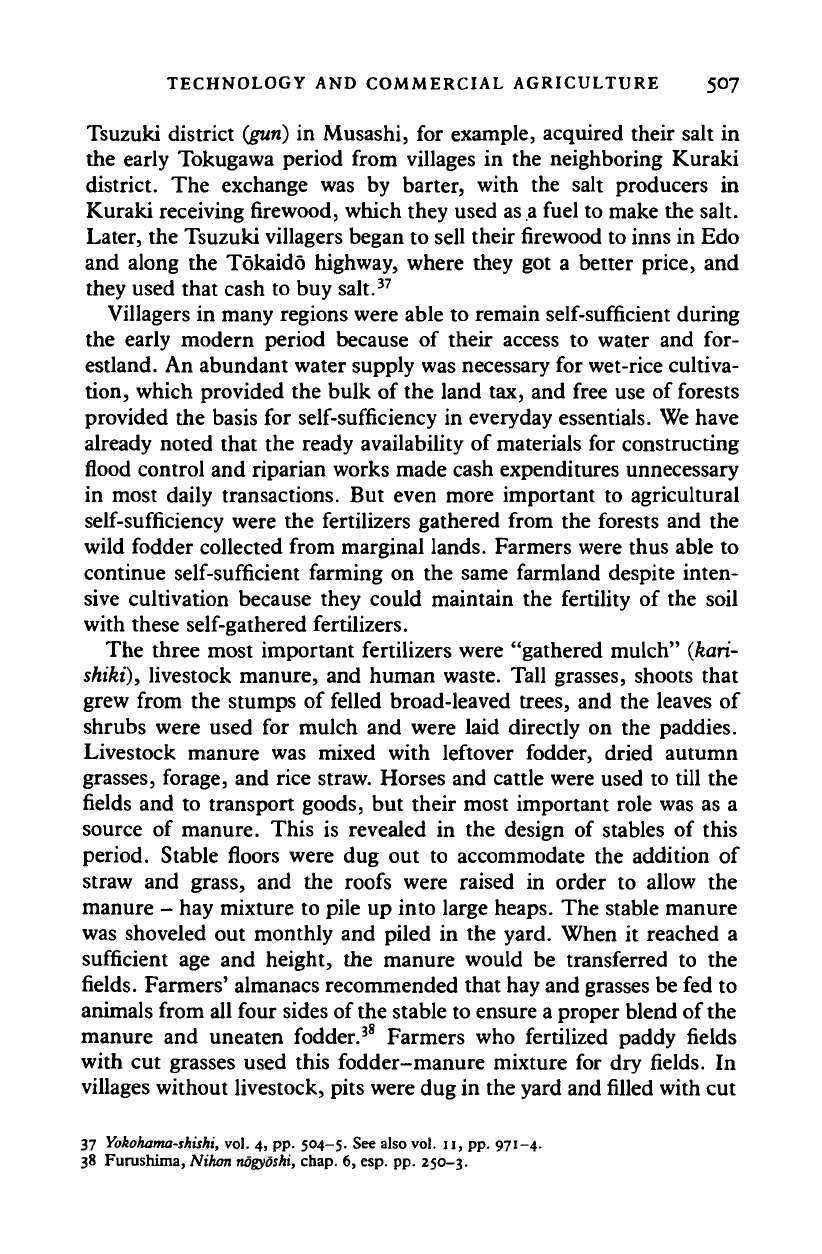
TECHNOLOGY AND COMMERCIAL AGRICULTURE 507
Tsuzuki district
(gun)
in Musashi, for example, acquired their salt in
the early Tokugawa period from villages in the neighboring Kuraki
district. The exchange was by barter, with the salt producers in
Kuraki receiving firewood, which they used as a fuel to make the salt.
Later, the Tsuzuki villagers began to sell their
firewood
to inns in Edo
and along the Tokaido highway, where they got a better price, and
they used that cash to buy salt.
37
Villagers in many regions were able to remain self-sufficient during
the early modern period because of their access to water and for-
estland. An abundant water supply was necessary for wet-rice cultiva-
tion, which provided the bulk of the land tax, and free use of forests
provided the basis for self-sufficiency in everyday essentials. We have
already noted that the ready availability of materials for constructing
flood control and riparian works made cash expenditures unnecessary
in most daily transactions. But even more important to agricultural
self-sufficiency were the fertilizers gathered from the forests and the
wild fodder collected from marginal lands. Farmers were thus able to
continue self-sufficient farming on the same farmland despite inten-
sive cultivation because they could maintain the fertility of the soil
with these self-gathered fertilizers.
The three most important fertilizers were "gathered mulch" (kari-
shiki),
livestock manure, and human waste. Tall grasses, shoots that
grew from the stumps of felled broad-leaved trees, and the leaves of
shrubs were used for mulch and were laid directly on the paddies.
Livestock manure was mixed with leftover fodder, dried autumn
grasses, forage, and rice straw. Horses and cattle were used to till the
fields and to transport goods, but their most important role was as a
source of manure. This is revealed in the design of stables of this
period. Stable floors were dug out to accommodate the addition of
straw and grass, and the roofs were raised in order to allow the
manure - hay mixture to pile up into large heaps. The stable manure
was shoveled out monthly and piled in the yard. When it reached a
sufficient age and height, the manure would be transferred to the
fields. Farmers' almanacs recommended that hay and grasses be fed to
animals from all four sides of the stable to ensure a proper blend of the
manure and uneaten fodder.
38
Farmers who fertilized paddy fields
with cut grasses used this fodder-manure mixture for dry fields. In
villages without livestock, pits were dug in the yard and
filled
with cut
37
Yokohama-shishi,
vol. 4, pp. 504-5. See also vol. 11, pp. 971-4.
38 Furushima, Nihon
nogyoshi,
chap. 6, esp. pp. 250-3.
Cambridge Histories Online © Cambridge University Press, 2008
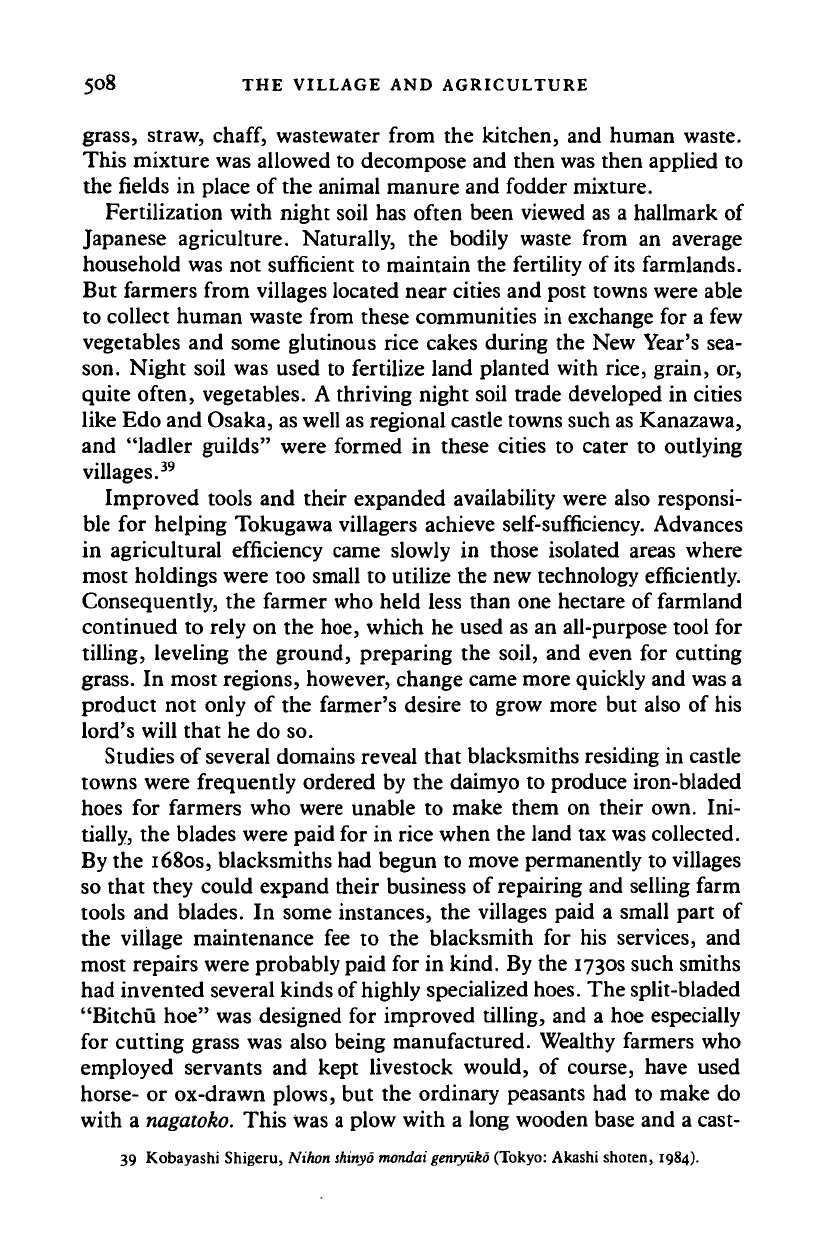
508 THE VILLAGE AND AGRICULTURE
grass,
straw,
chaff,
wastewater from the kitchen, and human waste.
This mixture was allowed to decompose and then was then applied to
the fields in place of the animal manure and fodder mixture.
Fertilization with night soil has often been viewed as a hallmark of
Japanese agriculture. Naturally, the bodily waste from an average
household was not sufficient to maintain the fertility of its farmlands.
But farmers from villages located near cities and post towns were able
to collect human waste from these communities in exchange for a few
vegetables and some glutinous rice cakes during the New Year's sea-
son. Night soil was used to fertilize land planted with rice, grain, or,
quite often, vegetables. A thriving night soil trade developed in cities
like Edo and Osaka, as well as regional castle towns such as Kanazawa,
and "ladler guilds" were formed in these cities to cater to outlying
villages.
39
Improved tools and their expanded availability were also responsi-
ble for helping Tokugawa villagers achieve self-sufficiency. Advances
in agricultural efficiency came slowly in those isolated areas where
most holdings were too small to utilize the new technology efficiently.
Consequently, the farmer who held less than one hectare of farmland
continued to rely on the hoe, which he used as an all-purpose tool for
tilling, leveling the ground, preparing the soil, and even for cutting
grass.
In most regions, however, change came more quickly and was a
product not only of the farmer's desire to grow more but also of his
lord's will that he do so.
Studies of several domains reveal that blacksmiths residing in castle
towns were frequently ordered by the daimyo to produce iron-bladed
hoes for farmers who were unable to make them on their own. Ini-
tially, the blades were paid for in rice when the land tax was collected.
By the 1680s, blacksmiths had begun to move permanently to villages
so that they could expand their business of repairing and selling farm
tools and blades. In some instances, the villages paid a small part of
the village maintenance fee to the blacksmith for his services, and
most repairs were probably paid for in kind. By the 1730s such smiths
had invented several kinds of highly specialized
hoes.
The split-bladed
"Bitchu hoe" was designed for improved tilling, and a hoe especially
for cutting grass was also being manufactured. Wealthy farmers who
employed servants and kept livestock would, of course, have used
horse- or ox-drawn plows, but the ordinary peasants had to make do
with a
nagatoko.
This Was a plow with a long wooden base and a cast-
39 Kobayashi Shigeru, Nihon
shinyo
mondai genryuko (Tokyo: Akashi shoten, 1984).
Cambridge Histories Online © Cambridge University Press, 2008

TECHNOLOGY AND COMMERCIAL AGRICULTURE 509
iron blade that had to be pushed by hand, and it could not cut even as
deeply as a hoe could.
40
The second most important farm tool was the sickle. It was usu-
ally used for weeding and cutting grass, as well as for chopping
down shrubs, trimming branches, and even hacking down trunks of
small trees. Sickles were even pressed into service as weapons by the
disarmed peasantry. With the sickle and hoe, the peasants could
carry out all of their farm duties. Moreover, they needed to buy only
the blades for these tools, as the handles and all other farm imple-
ments could be made by using material gathered from the communal
forestlands.
4
'
Self-sufficient agriculture was also defined and limited by the vari-
ety of crops cultivated and by the tiny amount of land available to grow
these different crops. Self-sufficient farmers paid their land taxes in
kind and usually planted all of their arable paddies with rice. If they
double-cropped their fields, they would most often grow wheat and
barley (usually more of the former than the latter) as winter crops to
feed their households. Wheat was usually ground into flour and eaten
as noodles or dumplings. For home consumption, dry fields were
planted with soybeans, millet, buckwheat, large white radishes, sweet
potatoes (in western Japan), and taro, especially along the Pacific
seacoast from Ise eastward into Suruga. Bits and pieces of spare land
around residences were also turned into gardens and planted with a
variety of vegetables.
An agricultural manual from a secluded mountain village in Shimo-
tsuke with a preface dated 1808 describes a typical harvest.
42
The
writer was a village headman
(nanushi)
who held nearly seven hectares
of land, about half of which was cultivated by his household in 1814.
However, the average peasant who appears in this manual farmed only
0.2 hectares of paddy and an equal amount of dry field. In one case
mentioned in the document, a peasant who worked a tiny plot of land
planted the paddy entirely with rice and cultivated other grains on the
dry fields, typically millet, soybeans, cotton, adzuki beans, buck-
wheat, tobacco, and cowpeas. The borders of these fields and any
remaining land were used for vegetables such as eggplant, autumn
radishes, and taro. This peasant's fields gave only minimal yields.
40 Furushima, Nihon
nogyoshi,
pp. 244-8.
41 Dai Nihon nokai, ed., Nihon
no
kama, kuwa,
suki
(Tokyo:
Nosei chosa iinkai, 1979). For
a
brief
discussion in English of agrarian technology, see Kee II Choi, "Technological Diffusion in
Agriculture Under the Bakuhan System," Journal of Asian Studies 30 (August 1971): 749-59.
42 Furushima, Nihon
nogyoshi,
pp. 344-6.
Cambridge Histories Online © Cambridge University Press, 2008
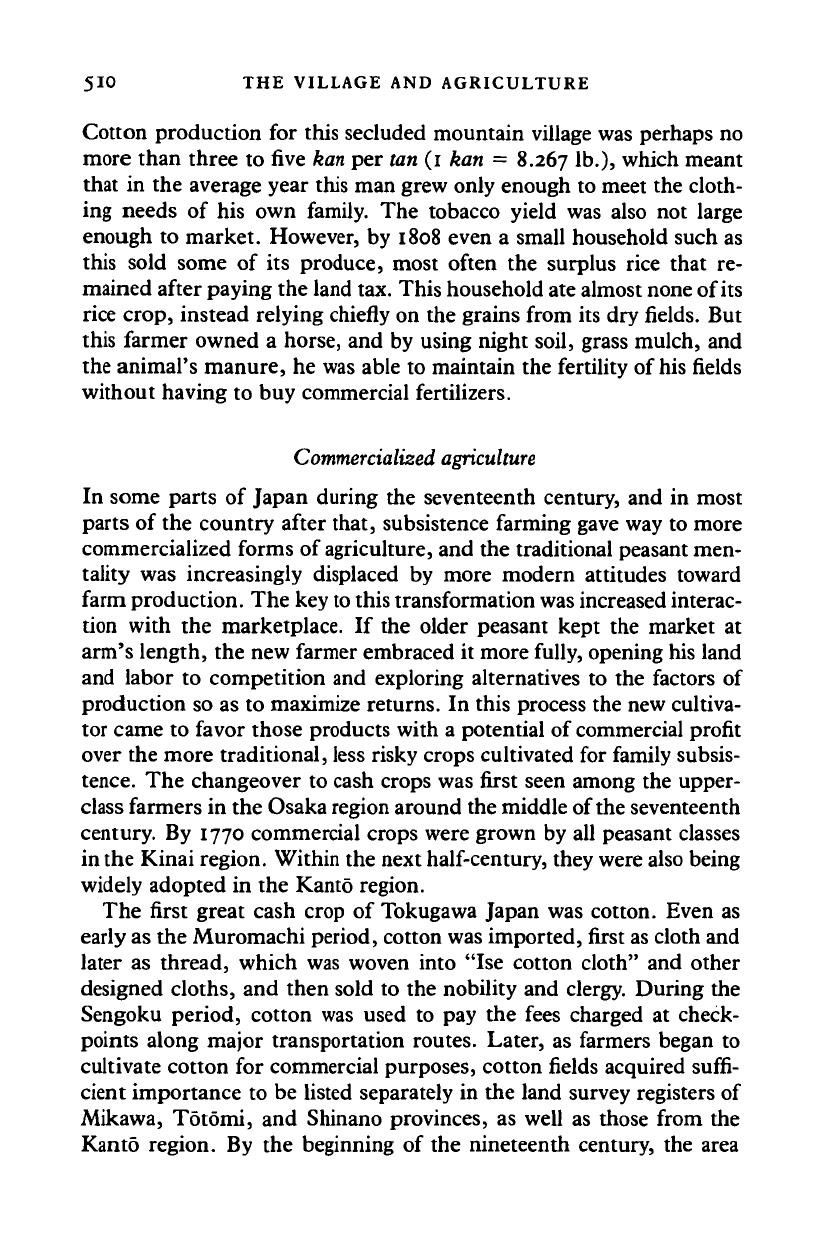
510 THE VILLAGE AND AGRICULTURE
Cotton production for this secluded mountain village was perhaps no
more than three to five kan per tan (i kan =
8.267
lb.)> which meant
that in the average year this man grew only enough to meet the cloth-
ing needs of his own family. The tobacco yield was also not large
enough to market. However, by 1808 even a small household such as
this sold some of its produce, most often the surplus rice that re-
mained after paying the land tax. This household ate almost none of its
rice crop, instead relying chiefly on the grains from its dry fields. But
this farmer owned a horse, and by using night soil, grass mulch, and
the animal's manure, he was able to maintain the fertility of
his
fields
without having to buy commercial fertilizers.
Commercialized
agriculture
In some parts of Japan during the seventeenth century, and in most
parts of the country after that, subsistence farming gave way to more
commercialized forms of agriculture, and the traditional peasant men-
tality was increasingly displaced by more modern attitudes toward
farm production. The key
to
this transformation was increased interac-
tion with the marketplace. If the older peasant kept the market at
arm's length, the new farmer embraced it more fully, opening his land
and labor to competition and exploring alternatives to the factors of
production so as to maximize returns. In this process the new cultiva-
tor came to favor those products with a potential of commercial profit
over the more traditional, less risky crops cultivated for family subsis-
tence. The changeover to cash crops was first seen among the upper-
class farmers in the Osaka region around the middle of the seventeenth
century. By 1770 commercial crops were grown by all peasant classes
in the Kinai region. Within the next half-century, they were also being
widely adopted in the Kanto region.
The first great cash crop of Tokugawa Japan was cotton. Even as
early as the Muromachi period, cotton was imported, first as cloth and
later as thread, which was woven into "Ise cotton cloth" and other
designed cloths, and then sold to the nobility and clergy. During the
Sengoku period, cotton was used to pay the fees charged at check-
points along major transportation routes. Later, as farmers began to
cultivate cotton for commercial purposes, cotton fields acquired suffi-
cient importance to be listed separately in the land survey registers of
Mikawa, Totomi, and Shinano provinces, as well as those from the
Kanto region. By the beginning of the nineteenth century, the area
Cambridge Histories Online © Cambridge University Press, 2008
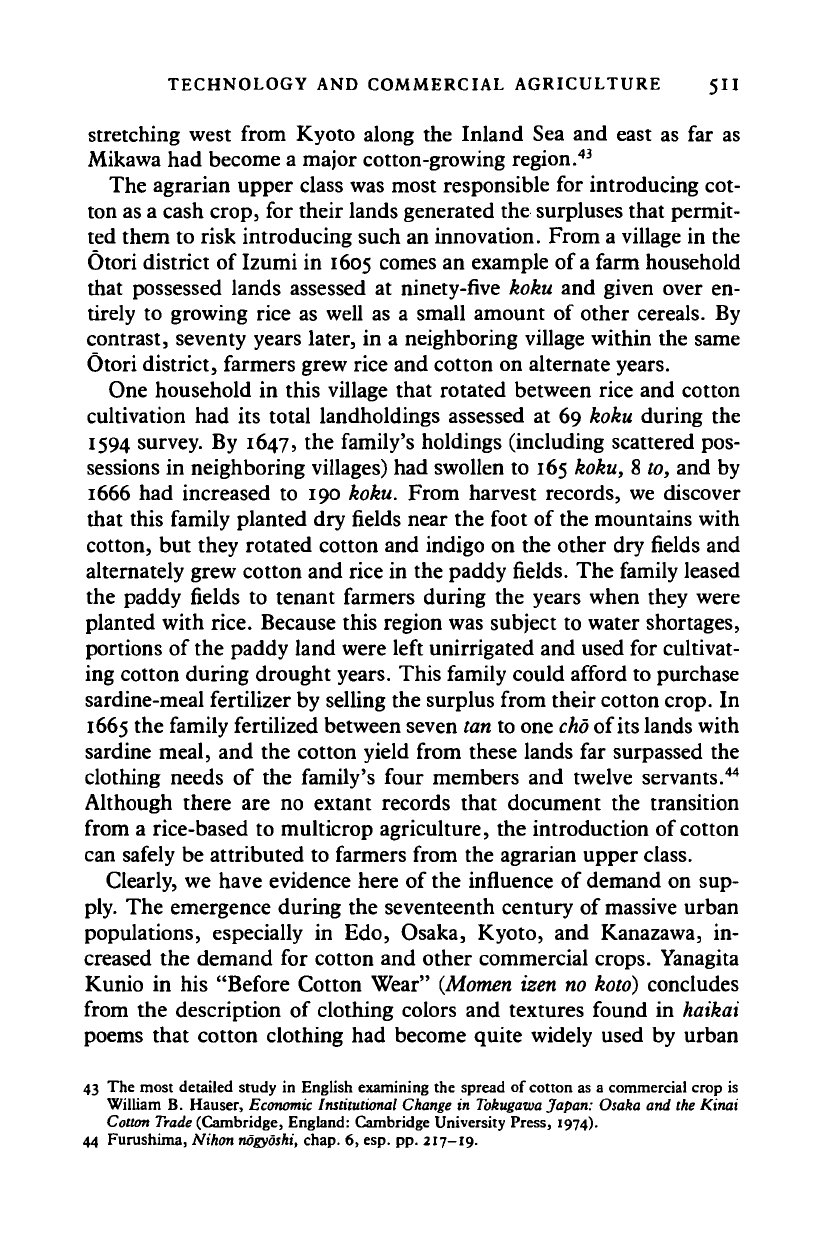
TECHNOLOGY AND COMMERCIAL AGRICULTURE 5II
stretching west from Kyoto along the Inland Sea and east as far as
Mikawa had become a major cotton-growing region.
43
The agrarian upper class was most responsible for introducing cot-
ton as a cash crop, for their lands generated the surpluses that permit-
ted them to risk introducing such an innovation. From a village in the
Otori district of Izumi in 1605 comes an example of
a
farm household
that possessed lands assessed at ninety-five koku and given over en-
tirely to growing rice as well as a small amount of other cereals. By
contrast, seventy years later, in a neighboring village within the same
Otori district, farmers grew rice and cotton on alternate years.
One household in this village that rotated between rice and cotton
cultivation had its total landholdings assessed at 69 koku during the
1594 survey. By 1647, the family's holdings (including scattered pos-
sessions in neighboring villages) had swollen to 165 koku, 8 to, and by
1666 had increased to 190 koku. From harvest records, we discover
that this family planted dry fields near the foot of the mountains with
cotton, but they rotated cotton and indigo on the other dry fields and
alternately grew cotton and rice in the paddy fields. The family leased
the paddy fields to tenant farmers during the years when they were
planted with rice. Because this region was subject to water shortages,
portions of the paddy land were left unirrigated and used for cultivat-
ing cotton during drought years. This family could afford to purchase
sardine-meal fertilizer by selling the surplus from their cotton crop. In
1665 the family fertilized between seven
tan
to one did of its lands with
sardine meal, and the cotton yield from these lands far surpassed the
clothing needs of the family's four members and twelve servants.
44
Although there are no extant records that document the transition
from a rice-based to multicrop agriculture, the introduction of cotton
can safely be attributed to farmers from the agrarian upper class.
Clearly, we have evidence here of the influence of demand on sup-
ply. The emergence during the seventeenth century of massive urban
populations, especially in Edo, Osaka, Kyoto, and Kanazawa, in-
creased the demand for cotton and other commercial crops. Yanagita
Kunio in his "Before Cotton Wear"
(Momen
izen no
koto)
concludes
from the description of clothing colors and textures found in haikai
poems that cotton clothing had become quite widely used by urban
43 The most detailed study in English examining the spread of cotton as a commercial crop is
William B. Hauser, Economic Institutional Change in
Tokugawa
Japan: Osaka and the Kinai
Cotton Trade (Cambridge, England: Cambridge University Press, 1974).
44 Furushima, Nihon
nogyoshi,
chap. 6, esp. pp. 217-19.
Cambridge Histories Online © Cambridge University Press, 2008
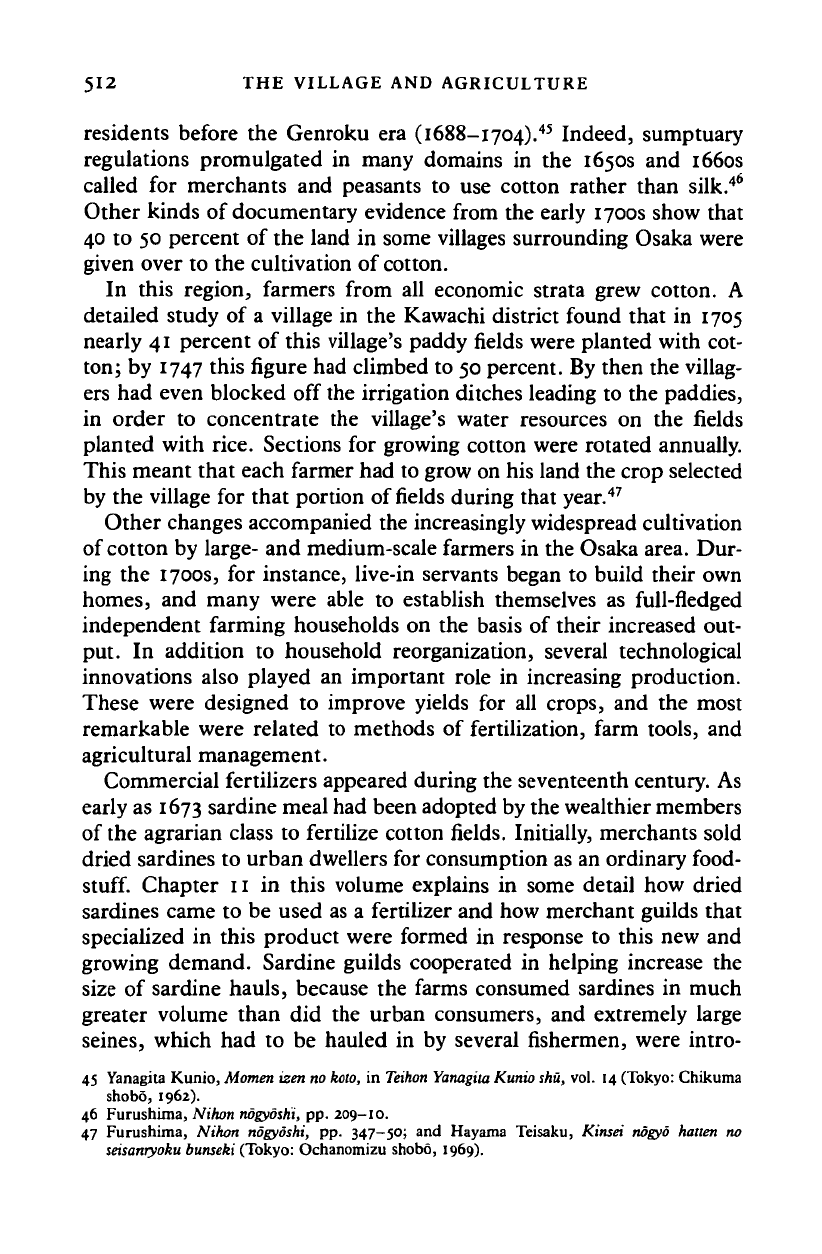
512 THE VILLAGE AND AGRICULTURE
residents before the Genroku era (1688-1704).
45
Indeed, sumptuary
regulations promulgated in many domains in the 1650s and 1660s
called for merchants and peasants to use cotton rather than silk.
46
Other kinds of documentary evidence from the early 1700s show that
40 to 50 percent of the land in some villages surrounding Osaka were
given over to the cultivation of cotton.
In this region, farmers from all economic strata grew cotton. A
detailed study of a village in the Kawachi district found that in 1705
nearly 41 percent of this village's paddy fields were planted with cot-
ton; by 1747 this figure had climbed to 50 percent. By then the villag-
ers had even blocked off the irrigation ditches leading to the paddies,
in order to concentrate the village's water resources on the fields
planted with rice. Sections for growing cotton were rotated annually.
This meant that each farmer had to grow on his land the crop selected
by the village for that portion of fields during that year.
47
Other changes accompanied the increasingly widespread cultivation
of cotton by large- and medium-scale farmers in the Osaka area. Dur-
ing the 1700s, for instance, live-in servants began to build their own
homes, and many were able to establish themselves as full-fledged
independent farming households on the basis of their increased out-
put. In addition to household reorganization, several technological
innovations also played an important role in increasing production.
These were designed to improve yields for all crops, and the most
remarkable were related to methods of fertilization, farm tools, and
agricultural management.
Commercial fertilizers appeared during the seventeenth century. As
early as 1673 sardine meal had been adopted by the wealthier members
of the agrarian class to fertilize cotton fields. Initially, merchants sold
dried sardines to urban dwellers for consumption as an ordinary food-
stuff.
Chapter 11 in this volume explains in some detail how dried
sardines came to be used as a fertilizer and how merchant guilds that
specialized in this product were formed in response to this new and
growing demand. Sardine guilds cooperated in helping increase the
size of sardine hauls, because the farms consumed sardines in much
greater volume than did the urban consumers, and extremely large
seines, which had to be hauled in by several fishermen, were intro-
45 Yanagita Kunio, Momen izen no koto, in Teihon Yanagita Kunio shu, vol. 14 (Tokyo: Chikuma
shobo, 1962).
46 Furushima, Nihon ndgyoshi, pp. 209-10.
47 Furushima, Nihon ndgyoshi, pp. 347-50; and Hayama Teisaku, Kinsei nogyo hatten no
seisamyoku bunseki (Tokyo: Ochanomizu shobo, 1969).
Cambridge Histories Online © Cambridge University Press, 2008
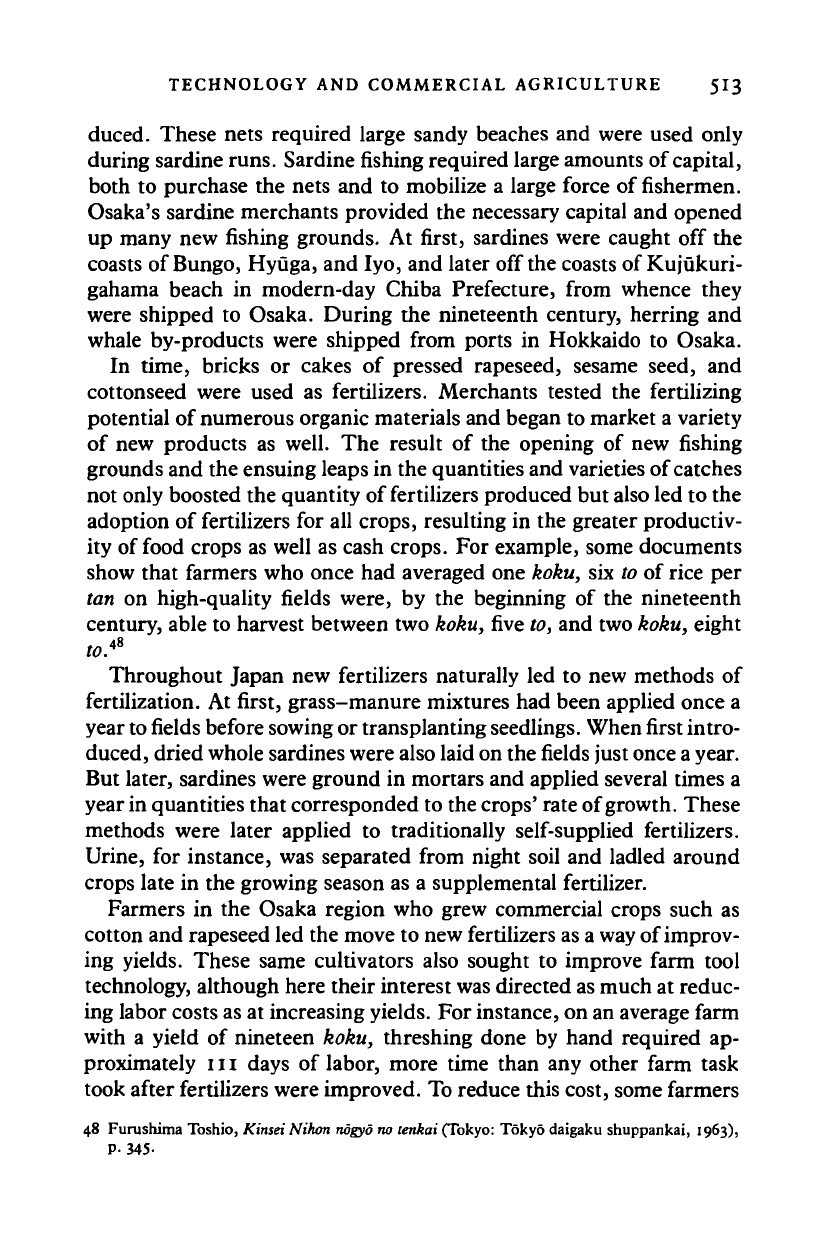
TECHNOLOGY AND COMMERCIAL AGRICULTURE 513
duced. These nets required large sandy beaches and were used only
during sardine runs. Sardine fishing required large amounts of capital,
both to purchase the nets and to mobilize a large force of fishermen.
Osaka's sardine merchants provided the necessary capital and opened
up many new fishing grounds. At first, sardines were caught off the
coasts of Bungo, Hyuga, and Iyo, and later off
the
coasts of Kujukuri-
gahama beach in modern-day Chiba Prefecture, from whence they
were shipped to Osaka. During the nineteenth century, herring and
whale by-products were shipped from ports in Hokkaido to Osaka.
In time, bricks or cakes of pressed rapeseed, sesame seed, and
cottonseed were used as fertilizers. Merchants tested the fertilizing
potential of numerous organic materials and began to market a variety
of new products as well. The result of the opening of new fishing
grounds and the ensuing leaps in the quantities and varieties of catches
not only boosted the quantity of fertilizers produced but also led to the
adoption of fertilizers for all crops, resulting in the greater productiv-
ity of food crops as well as cash crops. For example, some documents
show that farmers who once had averaged one koku, six to of rice per
tan on high-quality fields were, by the beginning of the nineteenth
century, able to harvest between two
koku,
five
to, and two koku, eight
Throughout Japan new fertilizers naturally led to new methods of
fertilization. At first, grass-manure mixtures had been applied once a
year
to
fields
before sowing or transplanting
seedlings.
When
first
intro-
duced, dried whole sardines were also laid on the
fields
just once
a
year.
But later, sardines were ground in mortars and applied several times a
year in quantities that corresponded to the crops' rate of growth. These
methods were later applied to traditionally self-supplied fertilizers.
Urine, for instance, was separated from night soil and ladled around
crops late in the growing season as a supplemental fertilizer.
Farmers in the Osaka region who grew commercial crops such as
cotton and rapeseed led the move to new fertilizers as a way of improv-
ing yields. These same cultivators also sought to improve farm tool
technology, although here their interest was directed as much at reduc-
ing labor costs as at increasing
yields.
For instance, on an average farm
with a yield of nineteen koku, threshing done by hand required ap-
proximately 111 days of labor, more time than any other farm task
took after fertilizers were improved. To reduce this cost, some farmers
48 Furushima Toshio, Kinsei Nihon nogyo no tenkai (Tokyo: Tokyo daigaku shuppankai, 1963),
P-345-
Cambridge Histories Online © Cambridge University Press, 2008
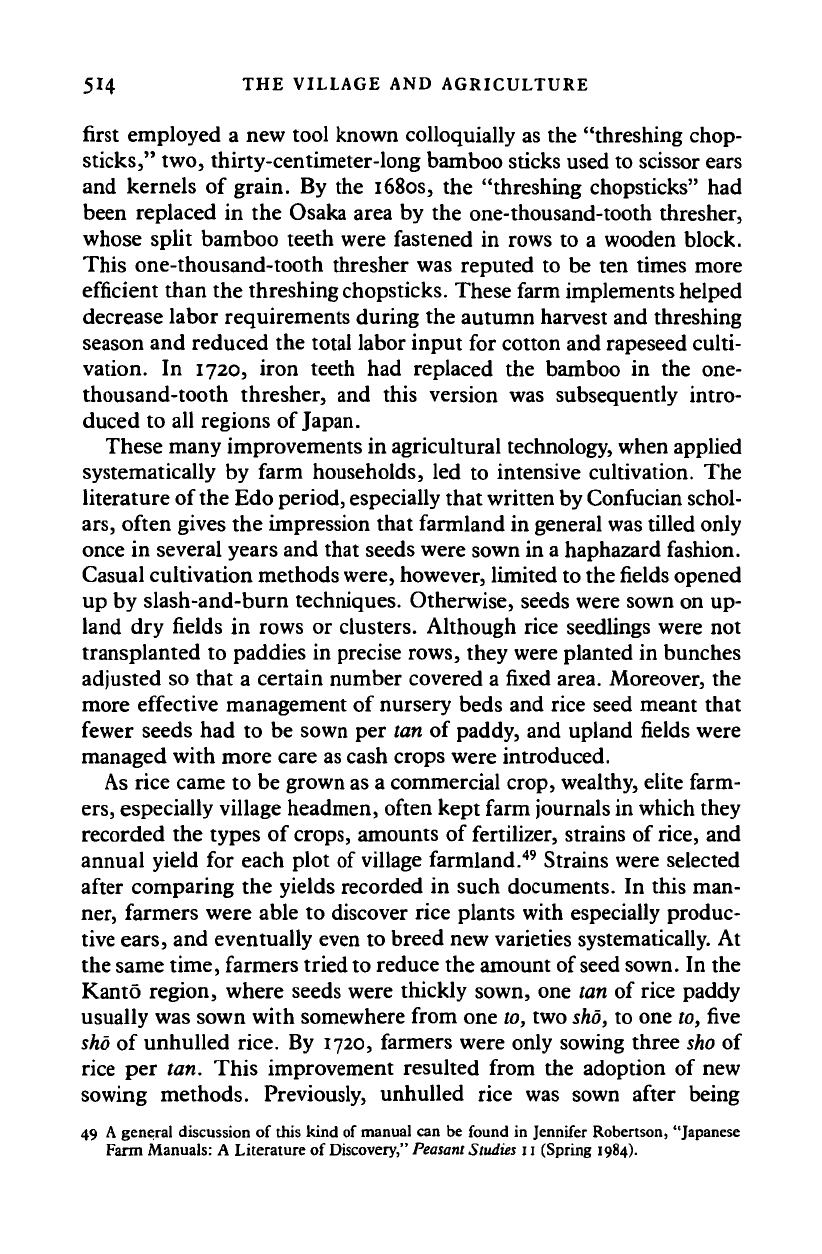
514 THE VILLAGE AND AGRICULTURE
first employed a new tool known colloquially as the "threshing chop-
sticks,"
two, thirty-centimeter-long bamboo sticks used to scissor ears
and kernels of grain. By the 1680s, the "threshing chopsticks" had
been replaced in the Osaka area by the one-thousand-tooth thresher,
whose split bamboo teeth were fastened in rows to a wooden block.
This one-thousand-tooth thresher was reputed to be ten times more
efficient than the threshing
chopsticks.
These farm implements helped
decrease labor requirements during the autumn harvest and threshing
season and reduced the total labor input for cotton and rapeseed culti-
vation. In 1720, iron teeth had replaced the bamboo in the one-
thousand-tooth thresher, and this version was subsequently intro-
duced to all regions of Japan.
These many improvements in agricultural technology, when applied
systematically by farm households, led to intensive cultivation. The
literature of the Edo period, especially that written by Confucian schol-
ars,
often gives the impression that farmland in general was tilled only
once in several years and that seeds were sown in a haphazard fashion.
Casual cultivation methods
were,
however, limited to the fields opened
up by slash-and-burn techniques. Otherwise, seeds were sown on up-
land dry fields in rows or clusters. Although rice seedlings were not
transplanted to paddies in precise rows, they were planted in bunches
adjusted so that a certain number covered a fixed area. Moreover, the
more effective management of nursery beds and rice seed meant that
fewer seeds had to be sown per tan of paddy, and upland fields were
managed with more care as cash crops were introduced.
As rice came to be grown as a commercial crop, wealthy, elite farm-
ers,
especially village headmen, often kept farm journals in which they
recorded the types of crops, amounts of fertilizer, strains of
rice,
and
annual yield for each plot of village farmland.
49
Strains were selected
after comparing the yields recorded in such documents. In this man-
ner, farmers were able to discover rice plants with especially produc-
tive ears, and eventually even to breed new varieties systematically. At
the same time, farmers tried to reduce the amount of seed sown. In the
Kan to region, where seeds were thickly sown, one tan of rice paddy
usually was sown with somewhere from one to, two
sho,
to one
to,
five
sho
of unhulled rice. By 1720, farmers were only sowing three
sho
of
rice per tan. This improvement resulted from the adoption of new
sowing methods. Previously, unhulled rice was sown after being
49
A
general discussion of this kind of manual can be found in Jennifer Robertson, "Japanese
Farm Manuals: A Literature of Discovery,"
Peasant Studies
1i (Spring 1984).
Cambridge Histories Online © Cambridge University Press, 2008
